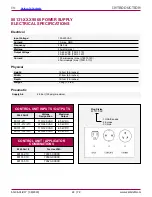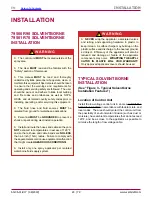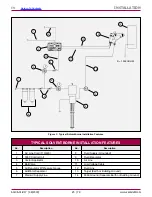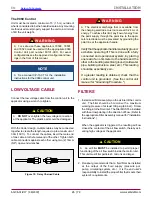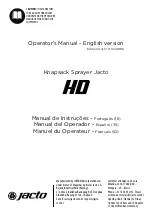
CAUTION
!
NOTE
CAUTION
!
WA R N I N G
!
ROUTINE SCHEDULE
Follow these maintenance steps to extend the life of the
applicator and ensure efficient oper-ation:
Several Times Daily
• Turn the control unit power to OFF!
• Inspect the air cap for paint accumulation. Clean as
frequently as necessary with a soft bristled brush and
a suitable solvent.
• Clean all insulating surfaces in the system. Remove
paint accumulation from the exterior of the applicator
and low voltage cable with a solvent dampened cloth.
Daily (or at start of each shift)
• Verify that ALL solvent safety containers are grounded!
• Check within 20 feet of the point of operation (of
the applicator) and remove or ground ALL loose or
ungrounded objects.
NEVER
soak or submerge the electrical compo-
nents of the applicator, i.e., barrel, hook, or cable.
Damage and failure may occur.
NEVER
remove the fluid nozzle assembly while
paint is in the applicator or paint may enter into the
air passages. Clogged or restricted air passages will
cause poor atomization and/or electrical shorting.
Air passages that are clogged with conductive
material can lead to excessive current output levels
and consequent low operating voltage or long-term
electrical damage. Before undertaking any atomizer
maintenance procedure, see "Applicator Assembly
Cleaning Procedure" in the "Maintenance" section.
The applicator barrel
MUST
be tilted front down
to remove the fluid nozzle. Failure to do so may
allow paint to enter the air passages, thereby
reducing airflow and damaging the applicator
barrel/cascade. Applicators may be flushed in lieu
of tilting. However, they must be either flushed
or tilted down during nozzle removal!
Standard electrode is "snap back" spray wire
electrode.
Paint and/or solvent supply must be turned off
during this test - risk of fire or explosion.
• Inspect work holders for accumulated coating
materials (and remove such accumulations).
• Check that atomizer assembly is clean and
undamaged.
• Straighten the applicator electrode if necessary.
• Clean the fluid filter, if used.
• Turn the control unit power ON.
• Run a current/voltage output test.
Electrical Current Output Test
1. Turn the paint and/or solvent supply OFF.
2. Trigger the applicator (high voltage ON).
3. Slowly approach the applicator electrode to any
grounded object and make contact.
4. Monitor the current output reading on the control
unit microamp meter as the applicator approaches
ground:
Upon ground contact, the microamp meter should
display 100 µA (for R90) or 90 µA (for R70) and the
green, yellow, and red LED's of the bar graph meter
will all be illuminated.
AH-06-01-R17 (08/2019)
36 / 79
www.carlisleft.com
MAINTENANCE
EN

